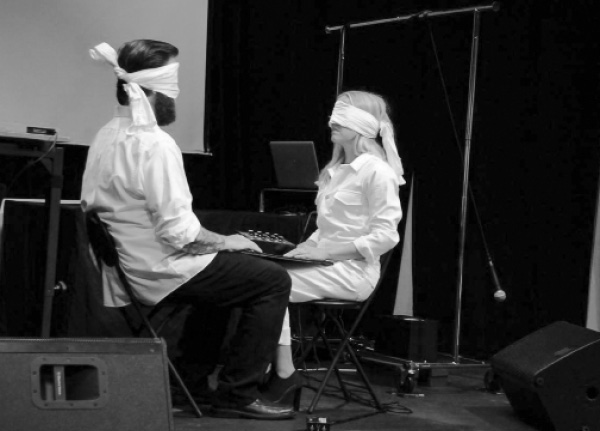
PHOTON ECSTASY (KEPLER-37) (2017)
first performed on April 28, 2017
Soft Series at NOMADLOFT, New York, NY
performed once in 2017
L'ARTISTE ORDINAIRE
(MELISSA GREY / DAVID MORNEAU / NICOLE ANTEBI)
New York, NY
nicoleantebi.com
artisteordinaire.org/concert-no-8-folk-geometry
PHOTON ECSTASY (KEPLER-37) (2017)
L'ARTISTE ORDINAIRE
On April 28, 2017, I joined L’Artiste ordinaire (Melissa Grey and David Morneau) as a fellow light traveler collaborating on “Photon Ecstasy (Kepler-37),” a permutation of their ongoing omnidirectional project that functions in a similar way to a stellar system with smaller groupings of stars or collaborators orbiting each other through gravitational attraction or mutual interest.
For this performance, Grey and Morneau, both blindfolded, manipulate a benjolin synthesizer and equip me with headphones and a separate audio track. These audio/visual constraints were utilized to remove the possibility of a response to the other’s cues creating a kind of isolation chamber contained within our own practice. We also rigged up a Chladni plate that responded to their frequencies. And, for my part, I visually projected, via digital microscope, a “live” animation for the audience. I dropped a variety of salt crystals onto the metal plate, and—unlike typical Chladni symmetrical shape formations—the salts moved gradually, skipping and gathering at intervals. The visual effect was more reminiscent of a stop-motion animation captured in a low frame rate rather than a uniform pattern. I tossed a few dead honeybees onto the plate as a kind of nod to a short film Melissa Grey and I had previously collaborated on. The film explored “The Telling of the Bees,” an early folktale about meaningful communication and mourning rituals between humans and honeybees. When the bees touched the plate they jumped, flipped forward, as if they were doing continuous somersaults in an anti-gravitational field. We called this performance a live animation. But this was vastly different from, say, those first animal locomotion studies by Eadweard Muybridge, which relied on the persistence of vision to create the illusion of movement historically marking the beginning of the moving image or cinema as we know it. This “live” animation was made in a single take, a magnification without use of a camera or spaces between frames. This was something different. To call this sonic animism or sonic agency gets closer to a movement derived and mediated through random frequencies—I’m still looking for the correct description of this performance. The documentation presented here falsely captures the performance as just described.